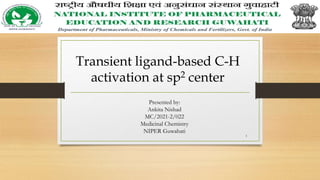
Transient ligand C-H activation
- 1. Transient ligand-based C-H activation at sp2 center Presented by: Ankita Nishad MC/2021-2/022 Medicinal Chemistry NIPER Guwahati 1
- 2. CONTENT • C-H activation • Directing groups • Limitations of directing group • Transient directing group • Comparison between directing group based C-H activation versus transient ligand-based activation • Important criteria for the design of a transient DG • C–H activation by transient phosphite DG • C–H activation by transient imine DG • Conclusion • Reference 2
- 3. C-H Activation • C-H activation refers to the formation of a complex wherein the C-H bond interacts directly with the metal catalyst or reagent. The complexes often afford a C-M intermediate in the absence of free radical or ionic intermediates. ……..Oxidative addition ……..Electrophilic activation 3
- 4. It is a catalytic reaction of transition metal complexes with the unreactive C―H bonds of alkenes, arenes, or alkyl chains to form products containing new metal-carbon bonds. Conventional Cross-Coupling Reaction And Its Drawbacks 1. Transition metal-catalyzed cross-coupling reaction e.g., Suzuki reaction It required large amount of organometallic reagents and aryl halides Losartan – Antihypertensive drug 4
- 5. 2. C–H activation with directing group approach Prefunctionilazion group is not required and it forms a single regioisomeric product Directing Groups Due to the presence of similar kinds of C―H bonds, transition metal may co-ordinate and hence functionalize any C-H center, leading to functionalization at more than one position, hence it lacks regioselectivity In the case of a heterocyclic ring system, the hetero atom governs the site selectivity towards the adjacent C-H center by pre-coordination with T.M. it is known as inherent selectivity 5
- 6. In case of simple aromatic or aliphatic system, governing regioselectivity is difficult in such a system DG comes to play, leading to regioselective C-H bond activation Limitations Of Directing Group 1. Directing group, if incorporated into a molecule, should be removable. Otherwise, it remains in the final molecule 2. Also, incorporation and removal of DG require extra two steps; hence step economy will be effected 3. Most of the directing groups allow functionalization only at the ortho position; therefore its limits the scope of the final product formed 6
- 7. TRANSIENT DIRECTING GROUP • The TDG approach involves the in-situ formation of an intermediate featuring the organic substrate and the directing groups for chelation-assisted C–H activation • Weakly coordinating units proximal to a targeted C–H bond enable the formation of a transition metallocyclic intermediate of suitable size and geometry • E.g., ketone derivatives, such as imines, oximes, hydrazones, and others • Transient directing C-H activation is also known as reversible directing group catalysis, temporary directing group catalysis, or traceless C-H activation 7
- 8. 8 Comparison between directing group based C-H activation versus Transient ligand-based activation Directing group-based Transient ligand-based DGs are difficult to remove after completion of the desired transformation, which represents a major drawback Transient DG (tDG) uses a functional group (FG) already installed at the substrate, temporarily transformed into a DG, and finally released (e.g., a ketone or carboxaldehyde) The C―H activation can reduce the procedures and thus making the reaction cost-effective and ecofriendly system It reduces the number of steps and atom-economical use of catalytic additives in a cooperative manner
- 9. Important criteria for the design of a transient DG in C–H activations : 9 1. Transient DG formation should occur with excellent levels of chemo-selectively, 2. The transient ligand should not interfere with the target transformation, 3. The transient ligand must be stable prior to and during the desired reaction, and 4. the formation of the transient DG must be reversible. Transient Directing Group Strategy for Site-Selective C–H Activation
- 10. 10 C–H Activation by Transient Phosphite DG The catalytic cycle was proposed to proceed by 1. oxidative addition of aryl bromides to rhodium(I), 2. coordination of the phosphinite co-catalyst to rhodium(III) species, and 3. subsequent cyclometallation followed by 4. reductive elimination to deliver the ortho-arylated phosphinite, which generates the co-catalyst, and liberates the 2-arylated product by transesterification ortho-C–H arylation of phenols with an aryl halide [RhCl(PPh3)3] - Wilkinson’s catalyst
- 11. 11 The reaction procedure was further simplified with the aid of commercially available P(NMe2)3 as the catalytic modifier to generate the phosphinite transient DG 1)oxidative addition 2) Coordination 3) Cyclometallation 4) Reductive elimination
- 12. 12 C–H Activation by Transient Imine DG The reversible in-situ imine formation because of acetophenones identified as viable substrates for alkene hydro-arylations in the presence of catalytic amounts of amines Reaction:
- 13. 13 Rhodium-Catalyzed Hydro-arylation of Alkenes with Aryl ketones Benzylamine was identified as the optimal catalytic modifier. No hydro-arylation product is observed in the absence of benzylamine.
- 14. 14 Conclusion C–H activation chemistry has emerged as a transformative platform for molecular syntheses and is characterized by improved atom and step economy compared with traditional cross-couplings. The generation of strongly coordinating DG by synergistic catalysis by the action of an organocatalyst and a transition-metal catalyst bears great potential for more sustainable syntheses. The transient DG approach enabled positional-selective C–H functionalization of substrates bearing weakly coordinating functional groups with the aid of co-catalytic modifiers through the reversible formation of phosphites or imines
- 15. 15 References (1) Gandeepan, P.; Ackermann, L. Transient Directing Groups for Transformative C–H Activation by Synergistic Metal Catalysis. Chem. 2018, 4 (2), 199–222. https://doi.org/10.1016/j.chempr.2017.11.002. (2) Goswami, N.; Bhattacharya, T.; Maiti, D. Transient Directing Ligands for Selective Metal-Catalysed C–H Activation. Nat. Rev. Chem. 2021, 5 (9), 646–659. https://doi.org/10.1038/s41570-021-00311-3. (3) Besset, T.; Zhao, Q.; Poisson, T.; Pannecoucke, X. The Transient Directing Group Strategy: A New Trend in Transition-Metal-Catalyzed C–H Bond Functionalization. Synthesis (Mass.) 2017, 49 (21), 4808–4826. https://doi.org/10.1055/s-0036-1590878. (4) Davies, H. M. L.; Morton, D. Recent Advances in C-H Functionalization. J. Org. Chem. 2016, 81 (2), 343–350. https://doi.org/10.1021/acs.joc.5b02818. (5) Bhattacharya, T.; Pimparkar, S.; Maiti, D. Combining Transition Metals and Transient Directing Groups for C–H Functionalizations. RSC Adv. 2018, 8 (35), 19456–19464. https://doi.org/10.1039/c8ra03230k.
- 16. 16